|
Celebrating National Public Safety
Telecommunicators Week
Part three: The next generation of call dispatching on its way
 Send a link to a friend
Send a link to a friend
 [April 14, 2021] [April 14, 2021]
Processing calls that come into the 911 Dispatch Office is a far
more complicated process than one would imagine. This week in
observance of National Public Safety Telecommunicators Week, LDN is
taking a walk through some of those processes with the help of Logan
County Dispatch Operations Manager Becky Langely and 911 Coordinator
Cheryl Hedrick.
When calls come into the Logan County 911 Center, the first job of
the dispatcher or telecommunicator is to determine the type of call
and react appropriately. Fire, accident, or police emergency calls
are all handled differently and require a different type of
questioning in order to direct the correct agency to the location of
the caller.
Of all the calls taken at the dispatch center, perhaps the most
complicated are those involving medical emergencies. In order to
accurately determine the scenario and relay correct and important
information to emergency responders, dispatchers utilize the
Computer Aided Dispatch (CAD) system. While the system is computer
assisted, the process begins very “old school,” with a carefully
organized set of flip cards lying on the workstation desk beside the
dispatcher.
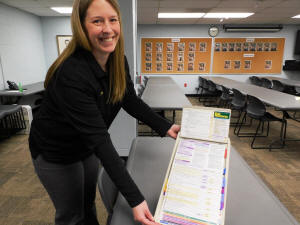
Langley explained how the card system works.

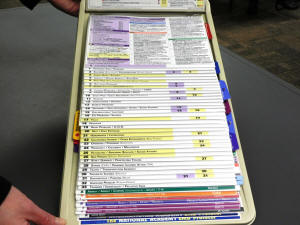
The card system is provided through Priority Dispatch, a leading
provider in tools to assist 911 dispatchers. There are more than 30
protocols that the cards cover in medical emergencies. The cards are
categorized according to the concern voiced by the caller. There are
short questions the dispatcher asks, and depending on the answer
then moves forward with the need assessment by asking additional
questions.
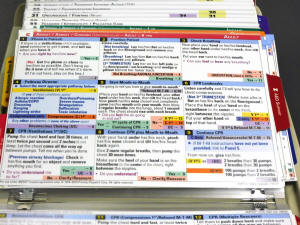
For example, if a caller says that he or she is with someone who
seems to have passed out and cannot be aroused, the dispatcher will
flip the cards to the section entitled “airway/arrest/choking
(unconscious)” and will begin asking questions of the caller.
Many of the cards are categorized according to the age of the victim
and other circumstances, such as is the victim a pregnant female, or
someone with preexisting health conditions.

Being unable to see the victim personally, answers to the questions
are the dispatchers only means of determining what could be wrong
and what should or should not be done immediately while waiting for
help to arrive.
As questions are being answered, information is also being typed
into the CAD on the computer.
Directions at the end of the question indicate how to move forward.
The card and its questions ultimately lead to what is called a
“determinate” code that is then given to the responding agency -
Logan County Paramedic Association (LCPA,) fire, police, etc. The
code in itself is of great value to the first responders as it gives
them an introduction to what they are driving into. It tells them
the degree of urgency for the call.
The card system also offers a guide to dispatchers for talking to
the caller about getting ready for the first responders to arrive.
This includes an assurance that help is on the way and some tasks
that the caller should perform while waiting such as gathering all
medications that the victim is currently taking and having those
ready to go with the patient when responders arrive.
There are occasions when immediate care is needed and will have to
be given by the caller. The dispatchers have guidance through this
card system on how to walk an untrained person through certain
processes such as CPR and even childbirth. This is important because
the dispatcher cannot see the person who is ill, and cannot do a
visual assessment of the situation. Therefore asking the right
questions and giving the proper guidance allows the caller to
administer what is needed to assist the victim while waiting for
help to arrive.
Langley said that the question cards are well organized and
structured to make sure that the dispatcher does a thorough job of
assessing the needs of the caller. At the same time, the cards are
not a script. Dispatchers react to each caller and work to keep the
caller calm and focused through their own delivery of the questions
and guidance through what to do next. She said that the QA cards are
based on years of research and study by the provider Priority
Dispatch. They are designed to be as efficient and effective as
possible, and are also always changing with new methods of
determining and assisting in a medical emergency.
Priority Dispatch, like the local 911 office, is always looking for
means to make the 911 call more efficient and more effective. As a
result, this year, the Logan County Dispatch will take a step
forward with a new version of its Priority Dispatch QA.
ProQA will be a new software installation on dispatch station
computers. With this upgrade, the cards will be phased out of use.
Instead of looking down and to the side to get guidance from the
cards, then up and to a computer screen to input information and get
a dispatch code for first responders, dispatchers will have the
advantage of staying face-forward during a call. Eyes will shift
from screen to screen but screens will be in line with one another
increasing the speed in which calls are processed.
[to top of second column] |

Langley said that in 2021 ProQA will still be a stand-alone protocol
where that dispatchers still use the answers to the questions to
assess the need and transfer that information to the CAD.
But, in 2022, hopefully in the early part of the year, there will be
another transition in the department to what is called “Next
Generation 911.” That upgrade will integrate the ProQA and CAD into
one process, again saving more time and making the response of the
dispatch more efficient and effective for the caller and the first
responders.
Hedrick and Langely explained that the new NG911 is a state mandated
move for the office, but incorporating the ProQA with NG911 is the
decision of the Logan County ETSB (Emergency Telephone Systems
Board)

And anytime a new big project comes about within local government
there is the question of who is paying for all this? Hedrick
explained that the 911 Dispatch is supported through the
telecommunication tax on phone bills. For many years there has been
a telecommunication tax on landline telephones to help support the
911 call system.
When cell phones began growing in popularity, the tax was not added
right away to the cell phone bills. For a number of years, the
telecommunication tax revenues fell, putting 911 call centers around
the state in financial jeopardy.
But, it was with the help of invested leaders such as retired EMA
Director Dan Fulscher that the state finally realized the need.
With the revitalization of the tax revenue, agencies are again able
to afford to operate an efficient and updated department.
Hedrick said that the state mandated upgrade to NG911 does not come
with state funding. The local revenues received from the tax will
have to cover the cost of that upgrade.
Langley said that the department does have the ability to cover that
cost and found it also had the ability to cover the cost of the new
ProQA software. Langley pointed out that the 911 department is not
in the business of making money, it is in the business of saving
lives. The investment the department is making is hefty, but it will
be worth every penny as it helps save lives within our community.

It should be noted that the telecommunication tax is not solely
disbursed to 911 offices. Hedrick explained that the Logan County
Dispatch receives only about half of the $1.50 per month that is
charged on landlines and cell phones. She said that there is also a
dollar figure added to the cost of pre-paid phones that is
determined in a different manner and not a constant dollar amount.
Staying with the topic of questions and answers, today’s helpful
tips come from Lindsey LaFrance and Regan Dahm. Langley noted that
callers sometimes become frustrated with the number of questions
they are being asked. LaFrance and Dahm’s hints will hopefully help
readers and potential callers understand the importance of being
patient and cooperative during the QA.
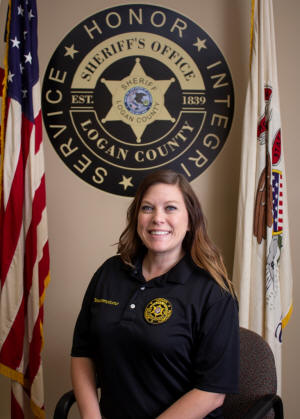
Lindsey LaFrance
When calling 911 the most important information you will give us is
the address of where your emergency is at. If that is the only
information we receive, we can still send help. We will ask lots of
questions at the very beginning of the call. Try to look around, and
be prepared to give where, what, when and who. Descriptions of those
involved and last direction of travel (if they have left) are
extremely important. You are our eyes and ears; we depend on you for
accurate information. We know calling 911 is stressful, and Logan
Dispatch is always here to assist you to the best of our abilities.

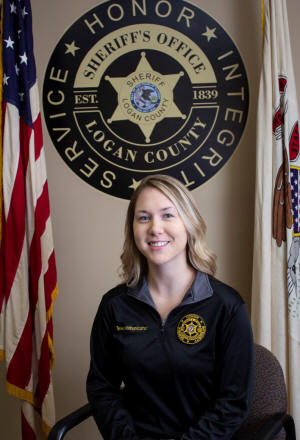
Regan Dahm
Calling 911 for an emergency currently occurring can be stressful,
scary and overwhelming. The Emergency Telecommunicators here at
Logan Dispatch will have a calming voice to get you through the
situation until responders arrive on scene. It is important to stay
calm, listen and answer the questions asked by the Telecommunicator
for us to collect accurate answers to pass along to the appropriate
responding personnel. Please, have patience while speaking to the
dispatcher even if it seems there are too many questions being
asked. We assure you the response will not be delayed. While
speaking with the Emergency Telecommunicator, their partner may
already be dispatching emergency personnel. Your cooperation is
critical for the Telecommunicators to efficiently take your call.
In the next segment of this series, Langley guides LDN on a tour of
the command center so we can show readers what is happening on the
other end of the phone when callers dial 911.
[Nila Smith with excerpts by Regan Dahm and Lindsey LaFrance] |